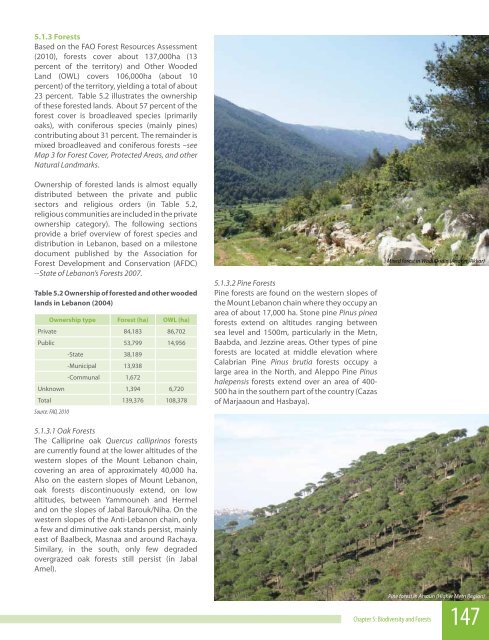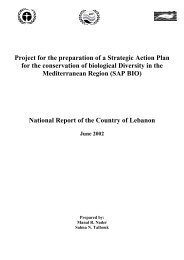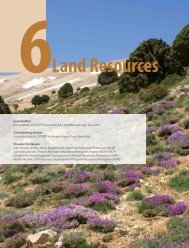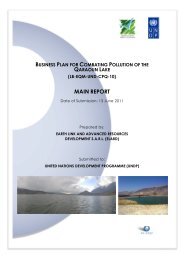Biodiversity and Forests
Biodiversity and Forests
Biodiversity and Forests
You also want an ePaper? Increase the reach of your titles
YUMPU automatically turns print PDFs into web optimized ePapers that Google loves.
5.1.3 <strong>Forests</strong><br />
Based on the FAO Forest Resources Assessment<br />
(2010), forests cover about 137,000ha (13<br />
percent of the territory) <strong>and</strong> Other Wooded<br />
L<strong>and</strong> (OWL) covers 106,000ha (about 10<br />
percent) of the territory, yielding a total of about<br />
23 percent. Table 5.2 illustrates the ownership<br />
of these forested l<strong>and</strong>s. About 57 percent of the<br />
forest cover is broadleaved species (primarily<br />
oaks), with coniferous species (mainly pines)<br />
contributing about 31 percent. The remainder is<br />
mixed broadleaved <strong>and</strong> coniferous forests –see<br />
Map 3 for Forest Cover, Protected Areas, <strong>and</strong> other<br />
Natural L<strong>and</strong>marks.<br />
Ownership of forested l<strong>and</strong>s is almost equally<br />
distributed between the private <strong>and</strong> public<br />
sectors <strong>and</strong> religious orders (in Table 5.2,<br />
religious communities are included in the private<br />
ownership category). The following sections<br />
provide a brief overview of forest species <strong>and</strong><br />
distribution in Lebanon, based on a milestone<br />
document published by the Association for<br />
Forest Development <strong>and</strong> Conservation (AFDC)<br />
--State of Lebanon’s <strong>Forests</strong> 2007.<br />
Table 5.2 Ownership of forested <strong>and</strong> other wooded<br />
l<strong>and</strong>s in Lebanon (2004)<br />
Ownership type Forest (ha) OWL (ha)<br />
Private 84,183 86,702<br />
Public 53,799 14,956<br />
-State 38,189<br />
-Municipal 13,938<br />
-Communal 1,672<br />
Unknown 1,394 6,720<br />
Total<br />
Source: FAO, 2010<br />
139,376 108,378<br />
5.1.3.1 Oak <strong>Forests</strong><br />
The Calliprine oak Quercus calliprinos forests<br />
are currently found at the lower altitudes of the<br />
western slopes of the Mount Lebanon chain,<br />
covering an area of approximately 40,000 ha.<br />
Also on the eastern slopes of Mount Lebanon,<br />
oak forests discontinuously extend, on low<br />
altitudes, between Yammouneh <strong>and</strong> Hermel<br />
<strong>and</strong> on the slopes of Jabal Barouk/Niha. On the<br />
western slopes of the Anti-Lebanon chain, only<br />
a few <strong>and</strong> diminutive oak st<strong>and</strong>s persist, mainly<br />
east of Baalbeck, Masnaa <strong>and</strong> around Rachaya.<br />
Similary, in the south, only few degraded<br />
overgrazed oak forests still persist (in Jabal<br />
Amel).<br />
5.1.3.2 Pine <strong>Forests</strong><br />
Pine forests are found on the western slopes of<br />
the Mount Lebanon chain where they occupy an<br />
area of about 17,000 ha. Stone pine Pinus pinea<br />
forests extend on altitudes ranging between<br />
sea level <strong>and</strong> 1500m, particularly in the Metn,<br />
Baabda, <strong>and</strong> Jezzine areas. Other types of pine<br />
forests are located at middle elevation where<br />
Calabrian Pine Pinus brutia forests occupy a<br />
large area in the North, <strong>and</strong> Aleppo Pine Pinus<br />
halepensis forests extend over an area of 400-<br />
500 ha in the southern part of the country (Cazas<br />
of Marjaaoun <strong>and</strong> Hasbaya).<br />
Mixed forest in Wadi Oudin (Andket, Akkar)<br />
Pine forest in Arsoun (Higher Metn Region)<br />
Chapter 5: <strong>Biodiversity</strong> <strong>and</strong> <strong>Forests</strong> 147





